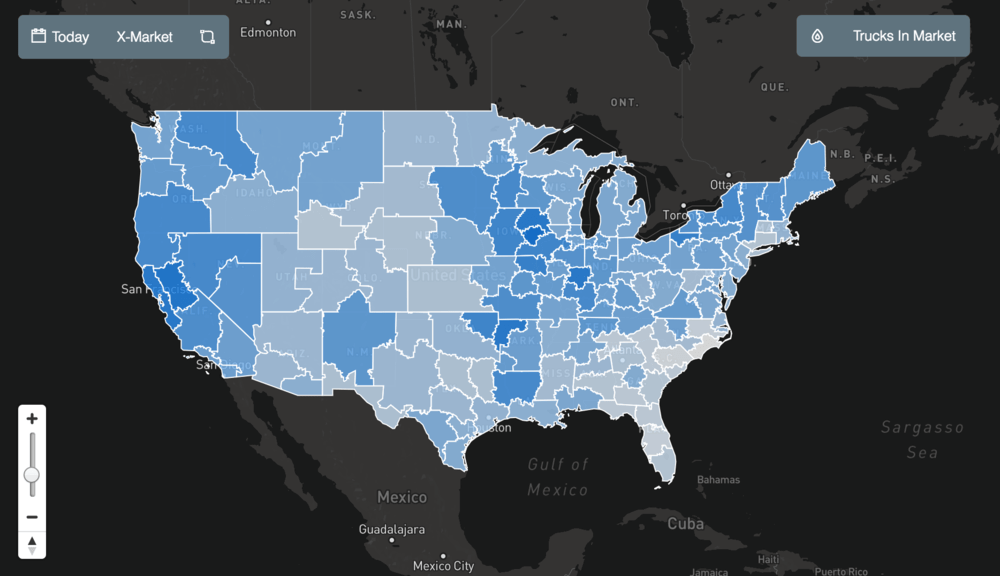North American Class 8 truck orders have soared to an all-time high, according to preliminary data from May.
ACT Research reported about 35,600 orders booked in May. FTR’s estimate came in just under that at 35,200, making last month the third highest May on record.
It wasn’t just a standout month for the industry, though. Record-breaking numbers have been coming in for months.
Year-to-date order numbers are sitting at about 206,000. That number goes up to about 244,000 when December 2017 is included, according to ACT Research Vice President and Senior Analyst Tim Denoyer.
Denoyer said the only other time a surge like this has been seen was during the mid-2000s pre-buy ahead of 2007’s stricter emissions mandates.
Order numbers climbed to 238,000 between December 2005 and May 2006.
“It is not a perfect comparison, but I think it’s fair to say that cumulatively this is the best six month period ever,” Denoyer said.
This year’s staggering numbers should start dropping off soon.
“From an order standpoint, we’re at the point where orders almost have to start coming down,” Denoyer said. “This year is almost sold out at this point.”
While a small number of orders do bleed into 2019, taking the total backlog and dividing by the build rate results in a seasonally adjusted time frame of about eight months to work through the entire backlog.
These large numbers cannot hold up much longer, but Denoyer said, at this point, falling order numbers do not represent decreasing demand.
FTR Vice President of Commercial Vehicles Don Ake echoed the sentiment of a sustained demand in a report released Tuesday.
“This is the tightest capacity crunch ever. Long-time veterans in this industry are saying this is the best freight market they have ever seen,” Ake said. “Fleets cannot add capacity fast enough and as long as the economy and manufacturing are going great, this capacity crisis will continue.”
Denoyer estimated that about two-thirds of the trucks being built this year represent replacement trucks, with the rest indicating fleet growth.
FreightWaves SONAR data shows that the majority of the U.S. has an above average number of trucks in market, which supports the notion that the industry is adding significant capacity, not just replacing existing trucks.

While Denoyer expects supply to increase in the used truck market next year, he is also optimistic about pricing due to continued demand.
“We know that supply of used trucks will increase next year,” Denoyer said. “That’s obviously a risk for pricing, but the counter for that is we’re seeing an increase in freight volume as well. . . Volume grew about 4 percent in 2017, and this year is looking even stronger.”
While Denoyer said there is enough demand to accommodate the increase in supply in the short term, he also acknowledged that the current freight cycle will likely come to an end in the next year.
“Our view is that this is probably going to slow down because freight cycles tend to last about two years historically,” he said. “This one has been going since about May of last year, so we’re about halfway into it.”
FreightWaves SONAR data indicates that prices for 3-year-old trucks in the used market are faring pretty well at the moment.

The huge number of new trucks being produced now will undoubtedly flood the used truck market in the next several years, but Denoyer said they could maintain decent residual value based largely on their quality.
“The fuel efficiency of trucks being built today is a lot better than in the past. Average fuel efficiency is roughly 6 to 6.5 miles per gallon,” he said. “Trucks rolling off the production line today are getting 8 and 8.5 miles per gallon. In five to six years those are going to be the trucks being traded out and going into the used truck market, so I think demand for that is going to be really strong.”
ACT Research does not forecast used truck values out five years due to its dependence on fluctuating supply and demand.
Stay up-to-date with the latest commentary and insights on FreightTech and the impact to the markets by subscribing.










